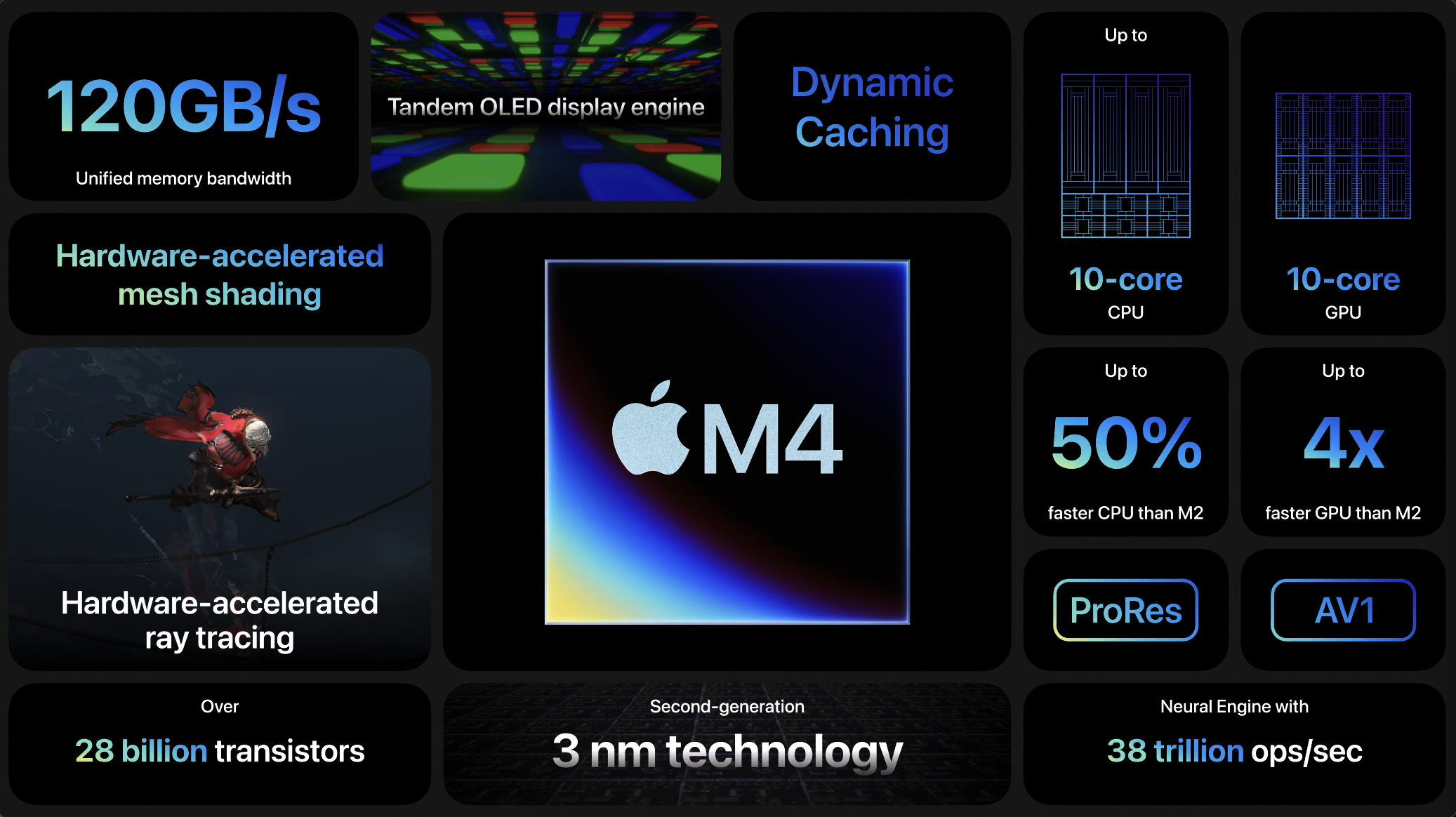Apple M4 chip: Everything you need to know

Apple has now been using its own silicon chips for four years. Despite the M3 chip only launching in late 2023, we have just seen the first batch of M4 devices — and it's likely not what you were expecting.
The M4 iPad Pro was announced at Apple's Let Loose event and it has 1.5x faster CPU performance than the already demonstrably powerful M2 chip in its tablet range.
Despite this incredible news, Apple has still not fully transitioned its devices away from M2, with the M2 Mac mini and M2 Mac Studio both being purchasable right now without a more powerful model. Unlike the M3 upgrade we were expecting, Apple's iPad Pro range will be skipping the chip altogether, just like the iMac which jumped from M1 to M3.
if you're looking to upgrade your M1 MacBook Air, we don't know when we can expect that M4 MacBook but, if you're in the market for an iPad upgrade, you are in luck. Here's everything we know about the M4 chip right now.
Apple silicon: the current picture
Here’s a current rundown of all the Macs Apple offers, and their respective chips:
- M3 MacBook Air 13/15-inch
- M3, M3 Pro, M3 Max MacBook Pro 14/16-inch
- M3 iMac
- M2, M2 Pro Mac mini
- M2 Max, M2 Ultra Mac Studio
- M2 Ultra Mac Pro
Here is the current lineup of iPads:
- M4 iPad Pro 11/13-inch
- M2 iPad Air 6 11/13-inch
- iPad 10 (A14 Bionic)
- iPad mini 6 (A15 Bionic)
Naturally, Apple’s M3-based Macs are younger and fresher, while the M2 desktops are a little further into their respective lifespans. Recently, Bloomberg’s Mark Gurman revealed that Apple is planning to move its Mac chips to “an annual refresh cycle,” just like its best iPhones. Gurman says 2024 will herald the start of that “if all goes to plan,” and that Apple is planning to release its first M4 Macs before the end of the year. This allows users to test out the AI capabilities of the iPad Pro range until then. Here’s a quick refresher on the story of Apple silicon so far.
iMore offers spot-on advice and guidance from our team of experts, with decades of Apple device experience to lean on. Learn more with iMore!
M4 chip release date

The M4 chip will be arriving alongside new iPad Pros on May 15. However, we have no confirmation about M4 Macs just yet.
A report in March claimed that Apple’s M4 MacBook Pro has just started formal development. Gurman’s timeline, issued in April, suggests the first products to launch are targeted for “around the end of 2024.” That would certainly preclude a launch at WWDC 2024, or even anything prior to the iPhone 16 and iPhone 16 Pro in September.
Apple could host a Mac event in either October or November of 2024 to unveil the new M4 chip and prospective new Macs (which we’ll come to). The alternative is that Apple could unveil M4 and accompanying Macs via press release, rather than an event.
But Gurman threw a curveball into the rumor mill in April 2024, reporting that Apple could include the M4 chip in the OLED iPad Pro first, expected to be unveiled at the 'Let Loose' event on May 7.
M4 chip specs, AI, and performance

As of right now, we only know what the iPad Pro's M4 chip is capable of, and some of that power is being used to operate the Ultra Retina XDR display, which effectively stacks two OLED panels on top of each other. Like the M3 before it, the M4 is built on 3nm technology but it is the second generation of its design, which allows for 28 billion transistors. Apple’s next major 2nm chip upgrade isn’t expected until 2025. On iPad Pro, the M4 chip is capable of powering a 10-core CPU, which is more than the 8 seen in the standard M3, and less than the 11 seen in the M3 Pro.
As pointed out in the Let Loose event, M4 CPU performance is up to 1.5 times faster than M2 performance on the iPad Pro. It also has a 10-core GPU, matching M3 MacBook performance, which is capable of Dynamic Caching — getting better performance from the chip. This chip allows for hardware-accelerated ray tracing on iPad for the first time.
Though the M4 chip on iPad Pro seems to suggest a relatively minor upgrade from the M3 chip, one particular upgrade worth noting is the Neural Engine. In the Let Loose event, Apple announced it is capable of 38 trillion operations per second, which works out to about 60 times faster than the Neural Engine found in the A11 Bionic. Unfortunately, no comparisons were made to more recent devices but this should make Apple AI even better when it eventually launches.
In February, EDN reported that Apple was planning to “significantly increase the number of built-in AI computing cores” in the M4 and A18 processors coming up this year so advancements in AI are likely to only increase as Macs get the M4 chip.
One of the biggest Apple silicon pain points is the 8GB of base unified memory in its cheapest Macs. While Apple insists that this is enough for base model users, M4 could be the perfect opportunity for Apple to set a new baseline of 16GB of unified memory for all of its Macs.
Apple M4 chip: Rumored Macs

So what products could M4 arrive in when it comes to Mac? Our most recent timeline from Gurman indicates that M4 could mark the first time that Apple pivots its entire Mac lineup to the latest generation of Apple silicon. This means we are hoping for an M4 version of every single Mac currently on the market. With this in mind, here's what we know so far, in chronological order based on Gurman’s most recent report:
M4 Macs
- 14-inch MacBook Pro, M4 - One of the first rumored M4 Mac products is a replacement for the M3 MacBook Pro, which was new to Apple’s lineup in 2024. More expensive than the old M2 MBP, it features the Pro’s more modern chassis and its excellent 120Hz ProMotion display - Gurman has tipped this for “around the end of 2024.”
- M4 iMac - The M3 iMac was unveiled in October 2023. Apple appears to have settled on its current slimline, colorful all-in-one design, so this is unlikely to change. Like the 14-inch Pro, Gurman has tipped this for the end of 2024, and a simultaneous launch seems very likely here.
- M4 Pro, Max MacBook Pro, 14/16-inch - Apple’s more premium MacBook lineup, which also features the 120Hz ProMotion display and Apple’s “Pro” and “Max” chips are tipped for a launch “between the end of 2024 and early 2025.” That window indicates they aren’t likely to drop alongside the iMac and the base MBP, however, Apple did release all three versions of the M3 MacBook Pro at once, so it might try to repeat this with the M4. Still, a spring 2025 launch sounds more likely.
- M4, M4 Pro Mac mini - Mac mini is one of the Macs still sporting M2, but with an M4 and M4 Pro update tipped for “between the end of 2024 and early 2025,” and the M3 version in the meantime seems redundant. Apple’s Mac mini is so small that design changes and tweaks seem unlikely here, and there’s very little to dislike about Apple’s most affordable desktop.
- M4 MacBook Air, 13/15-inch - Apple’s most recently-updated Mac, Gurman says that we should expect to wait a full year for the new M4 version, which he tips for “around spring 2025.”
- M4 Mac Studio - Gurman says a new M4 version of the Mac Studio is coming “around the middle of 2025.” Like the Mac mini, we’re currently on the M2 Max and Ultra versions of the Mac mini, so while an M3 version isn’t totally off the cards, the current version is more than powerful enough to see us through the next year.
- M4 Ultra Mac Pro - Finally, the all-powerful Mac Pro is expected in the second half of 2025. The previous M2 version sports the same top-end chip as the Studio, raising some questions about its usefulness in the post-Intel Mac era. While this could be the perfect vessel for that M4 Extreme chip pondered above, Gurman refers to the M4 Ultra here.
Apple silicon: A history

M1
Apple announced its transition from Intel to Apple silicon at WWDC in June 2020. Its M1 chip followed shortly after in November. Apple’s first system on a chip (SoC) featured four high-performance cores and four high-efficiency cores. Built on the 5nm manufacturing process, its 16 billion transistors delivered 3.5x faster CPU and 6x faster GPU performance than Intel Macs of old while doubling their battery life for its best MacBooks.
M1 Pro and M1 Max followed in October 2021. The former boasted a 10-core CPU with eight high-performance cores that were 70 percent faster than M1. The latter was a 10-core CPU with a 32-core GPU and the most powerful chip Apple had ever made until March 2022. M1 Ultra was essentially two M1 Max combined using Apple’s UltraFusion technology, a custom-built architecture that connected the two chips. M1 Ultra featured a 20-core CPU and 64GB GPU, as well as up to 128GB of Unified Memory.
M2
Barely three months later, Apple unveiled the new base-model M2 chip. Sharing many similar characteristics of the first-generation, the M2 chip boasted significant boosts to the CPU, GPU, and unified memory speeds.
The M2 Pro and M2 Max chips debuted in January 2023. M2 Pro introduced 10 and 12-core options, more memory bandwidth, and up to 19 GPU cores, while M2 Max went further still with up to 38 GPU cores.
Finally, in June 2023, Apple unveiled the M2 Ultra, following the same formula as the M1 Ultra. It offered a 20 percent faster CPU and a 30% faster GPU. With no M3 Ultra forthcoming, the M2 Ultra remains Apple’s fastest-benchmarking multi-core chip according to benchmarks.
M3
Just a few months later in 2023, Apple debuted M3, M3 Pro, and M3 Max. As you can see, the speed at which Apple turns out chips has increased dramatically since M1, adding credence to the idea that M4 is probably just around the corner.
The biggest upgrade to the M3 chip was its new 3nm process technology, which packed in more transistors into the same space. M3 also boasted efficiency and performance cores that were 30 percent and 15 percent faster than M2 respectively, with even heftier gains over M1.
M3 Pro featured a 12-core CPU and an 18-core GPU, while M3 Max took us to a 16-core CPU with up to 40 GPU cores and 128GB of memory. As noted, no M3 Ultra has been forthcoming. Bloomberg’s Mark Gurman says an M3 Ultra “does exist internally at Apple,” but that the company “could choose to wait until the M4 line.”
So there you have it, everything we know about Apple's future products including the M4 chip so far. We will see M4 on Apple's best iPads first, before the chip arrives on Macs later this year.
It could be until September before we hear anything about M4 Macs, and likely longer than that. Before then, Apple will lay the groundwork for its future Macs and iPads with macOS 15 and iPadOS 18 at WWDC 2024.

Stephen Warwick has written about Apple for five years at iMore and previously elsewhere. He covers all of iMore's latest breaking news regarding all of Apple's products and services, both hardware and software. Stephen has interviewed industry experts in a range of fields including finance, litigation, security, and more. He also specializes in curating and reviewing audio hardware and has experience beyond journalism in sound engineering, production, and design.
Before becoming a writer Stephen studied Ancient History at University and also worked at Apple for more than two years. Stephen is also a host on the iMore show, a weekly podcast recorded live that discusses the latest in breaking Apple news, as well as featuring fun trivia about all things Apple. Follow him on Twitter @stephenwarwick9
